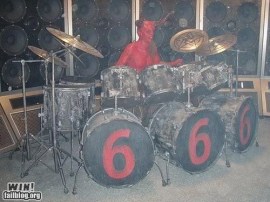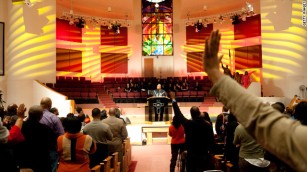 Roberto is the drummer on the Worship Team at our church. Nowadays, that might not seem like a big thing; churches not only have drummers, but 3 loud guitars, smoke machines, complicated lightning schemes and the most cutting edge worship music available. Some worship bands look more like they’re performing a rock concert than leading people in actual worship. They have “Worship” in their name for a reason, and a lot of worship bands would do well to remember that more often.
Roberto is the drummer on the Worship Team at our church. Nowadays, that might not seem like a big thing; churches not only have drummers, but 3 loud guitars, smoke machines, complicated lightning schemes and the most cutting edge worship music available. Some worship bands look more like they’re performing a rock concert than leading people in actual worship. They have “Worship” in their name for a reason, and a lot of worship bands would do well to remember that more often.
But at our church, the fact that we have a regular drummer every week, and he’s an integral and fully accepted part of our Worship Team, is a big step forward for us. One of the biggest problems we’ve ever had at our church is the long-standing resistance to change in the music from the older members of the congregation. Folks who had been at this church 30 years were threatening to leave; first it was because we used choruses (some of which were written in the ‘70s) in addition to hymns. Then it was because we used some choruses that weren’t lifted directly from scripture. Then it was because we started incorporating a drum kit into our worship. Then it was the electric guitar. And worst of all, a few people thought our church shouldn’t do these things because they were somehow un-Christian or satanic.
Roberto is the one and only drummer our Worship Team has. No backups. When he’s not there, we just don’t have any drums, and the music suffers. In one of his most candid and naked moments, he told me about how hard it is to be such a visible figure of what some members of our congregation (even still) didn’t want. When he got down to specifics, he said what people had the biggest problem with was cymbal crashes. He uses them sparingly, but occasionally in practice he’ll cut loose with some crazy cymbal-snare-tom freak-out, like a little storm that lasts 5 seconds, reminding me distinctly of Neil Peart.
It’s mystifying to me. Cymbals? Really? Why, out of all the features of drumming, do you pick out cymbals to be the top church-disturbing thing?
 If I step outside myself for a moment, I can actually see the elder church members’ point, and it’s because my mom has a form of the same point. (You’re not an elder, mom – didn’t mean to imply that) My mom was an MK – Missionary Kid, that is – in Guatemala, so she grew up in a church that was largely cut off from the American Christian experience. In a way, that makes it purer, but it also makes it slower to change. To her, church music is all about hymns. She loves hymns, and I’ve learned to love hymns because I love her. And since her love of hymns reaches so deep, to the very depths of her childhood, it makes her profoundly sad to see our modern church society where hymns are all but forgotten, even disrespected. So it makes sense for her to have some angst directed at what has replaced them. I get it.
If I step outside myself for a moment, I can actually see the elder church members’ point, and it’s because my mom has a form of the same point. (You’re not an elder, mom – didn’t mean to imply that) My mom was an MK – Missionary Kid, that is – in Guatemala, so she grew up in a church that was largely cut off from the American Christian experience. In a way, that makes it purer, but it also makes it slower to change. To her, church music is all about hymns. She loves hymns, and I’ve learned to love hymns because I love her. And since her love of hymns reaches so deep, to the very depths of her childhood, it makes her profoundly sad to see our modern church society where hymns are all but forgotten, even disrespected. So it makes sense for her to have some angst directed at what has replaced them. I get it.
But God would not have us be stagnant and unmoving. God is all about our growth and forward motion, both in our individual lives and as a Church (that’s with a capital C). And this has been a hard lesson for me to learn, but for those in the grip of grace, for those who trust in the Lord, there isn’t anything to fear from change. Change is good.
So what about cymbals? Were it merely on a practical level, without all this “IT’S SATANIC!!!” garbage, I think I could at least understand it. Cymbals are, by their very nature, crashing. That’s why one type of them is called a crash. Crashes are typically played on the first beat of a four-measure or eight-measure figure, like at the beginning of a verse or a chorus. And their primary function is to add punctuation to the beat, piercing your consciousness in the process. And let’s face it – old people don’t like having their consciousnesses pierced (or their eardrums). Maybe the reason certain elders of our church’s congregation have objected to cymbals (and drums in general) in the past isn’t “it’s unholy” or “we must avoid the appearance of evil,” but that they simply don’t like them. That, at least, makes sense to me.
 Melt by Peter Gabriel is a landmark album for him in many ways, but the most radical is this: it doesn’t contain any cymbals. Not a single crash, ride or hi-hat, not a single hit of the brass anywhere on the album. This was intentional – Gabriel, though he’s a multi-instrumentalist, doesn’t play the drums, so he instructed Phil Collins (who guested on a few tracks) and regular drummer Jerry Marotta that this was his concept for the album. This made the music more primitive, more elemental, and recalled images of jungle tribesmen in Africa with painted bodies and feathers on their clothes. And even though Melt deals with real world issues like no other previous Gabriel album, the inflection of the whole thing is one of elemental human reaction, of listening to your gut above all other things.
Melt by Peter Gabriel is a landmark album for him in many ways, but the most radical is this: it doesn’t contain any cymbals. Not a single crash, ride or hi-hat, not a single hit of the brass anywhere on the album. This was intentional – Gabriel, though he’s a multi-instrumentalist, doesn’t play the drums, so he instructed Phil Collins (who guested on a few tracks) and regular drummer Jerry Marotta that this was his concept for the album. This made the music more primitive, more elemental, and recalled images of jungle tribesmen in Africa with painted bodies and feathers on their clothes. And even though Melt deals with real world issues like no other previous Gabriel album, the inflection of the whole thing is one of elemental human reaction, of listening to your gut above all other things.
Maybe I should sit those elder members of our congregation down and make them listen to Melt. After all, they wanted no cymbals! I kid…
Next: September ’77, Port Elizabeth, weather fine…






 It was a red-letter day when our family got our first CD player. On Christmas 1992, we opened up our presents one at a time like normal, but at the end my dad said we weren’t done yet. He pulled out presents from “Santa,” one for each of him, my sister and myself, and two for mom. Mom opened her big one first, and it was said player. It was black and clunky, to be a part of our old-school stereo setup. Back in those days the pattern was still to have a fancy stereo receiver wired to separate speakers and a sub-woofer, placed at strategic equidistant points in the room; then you had separate turntable, cassette and CD units. They all stacked on top of each other, with the turntable going on top.
It was a red-letter day when our family got our first CD player. On Christmas 1992, we opened up our presents one at a time like normal, but at the end my dad said we weren’t done yet. He pulled out presents from “Santa,” one for each of him, my sister and myself, and two for mom. Mom opened her big one first, and it was said player. It was black and clunky, to be a part of our old-school stereo setup. Back in those days the pattern was still to have a fancy stereo receiver wired to separate speakers and a sub-woofer, placed at strategic equidistant points in the room; then you had separate turntable, cassette and CD units. They all stacked on top of each other, with the turntable going on top. But back to Christmas. After the
But back to Christmas. After the  My mother had some unusual musical habits. In addition to Simon & Garfunkel, she loved
My mother had some unusual musical habits. In addition to Simon & Garfunkel, she loved